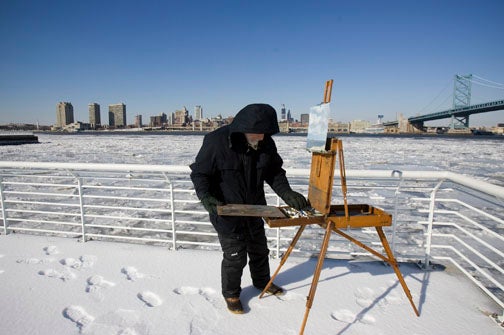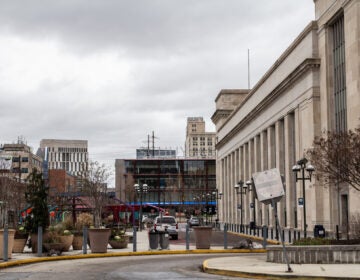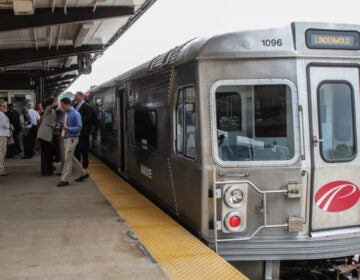River runs through the art world

By Linda K. Harris
For Plan Philly
The Delaware River, flowing for thousands of years alongside the banks of what for a few hundred years has been one of America’s great cities, has served as muse to painters, musicians and poets, drawn to its banks by its natural powers. With dancing light, the gently lyrical melody of moving waters and the shifting colors of reflected light, the river has attracted those with the gift of expression.
“I can see it without the bridges or without the roads or the refineries … look at the place and say, this must have been all trees,” says Ardmore painter Joseph Sweeney www.joesweeneyart.com.
Sweeney has cast his eye upon the river from many vistas, usually creating small paintings that he can take back to his studio, where he will increase the scale and use pastels on a larger canvas. Sometimes, he spends more time on location, trying to capture the fleeting color scheme of a precise moment. Then he’ll photograph the image for the sake of composition and continue to the larger painting. But always he has in mind the river’s more innocent days.
“It was always a clear river, always free flowing. It used to have an incredible shad fishery in there. There used to be sturgeon running up and down.”
Sweeney has been painting landscapes since 1980 and last fall, he mounted a one-man show of pastels called “Rivers” at Gross McCleaf Gallery in Center City.
“I’m always working along the rivers because you get a more open view than when you work from the woods, let’s say. You can look down and see a lot further,” Sweeney said.
“A few years back, I did one that was just above the Ben Franklin Bridge where I had a tug going up the river, toward Trenton.”
That painting, “Heading For Trenton,” became a part of the “Rivers” show. www.grossmccleaf.com/imagepages/sweeneyheadingfortrenton.html
Sweeney is fascinated by the river’s ever-changing hues. “Most of it has that brackish-brown look. It’s kind of a raw umber with a little bit of white. A little raw sienna in it from time to time. Most rivers take their color from the sky. If you have a nice sky-blue day, the river looks blue, but if you’re looking straight down into the river, you see the brown.”
The light of the Delaware is always shifting and redefining the river’s palette. “You’ll see it in the morning and it will have one look and by sunset, it’s totally different,” he said.
Before Sweeney attempts to cast color to canvas, he wants to know the history of the natural phenomenon, be it meadow, tributary or hill and the Delaware River is no exception. It’s an important step for him in the process of imagining.
During Sweeney’s quest to understand the Delaware, he came upon the story of Thorfinn Karlsefni. An Icelandic Viking adventurer credited with exploring North America sometime between 1002 and 1015, Karlsefni is said to have established a Viking colony along the Delaware River. A statue commemorating Karlsefni, created in 1918 by the Icelandic sculptor Einar Jonsson, is in place along Kelly Drive near Boat House Row www.philart.net/year.php?id=1918. It is said that the colony included 165 men and 35 women and that Karlsefni’s son, Snorri, was born there.
John McPhee’s book Looking for a Ship (Farrar, Straus & Giroux, 1990) recounts the tale: “One of our pilots was Jonas Thorsteinsson, a fountain of sea stories and the author of the basic Icelandic text on celestial navigation. He is a naturalized American citizen, and, like all the other canal pilots, has four weeks of vacation for every six weeks he works. His home and family are in Pensacola. As skipper of a research vessel in the North Pacific, he once dropped an anchor that took nearly half an hour to reach bottom. He said all these things as he moved the Stella Lykes from lock to lock, easily juggling his stories with his commands to the helmsman. He told me about the Icelandic child Snorri Thorfinsson, who was born on an island in the Delaware River, quite near the site of Philadelphia, in June 1002.
The baby’s father was Thorfinnur Karlsefni, Jonas said. The baby’s mother was Gudridur Thorbjarnsdottir. Jonas had read Thorfinnur’s logs at the National Library in Reykjavik. After three years, Thorfinnur and family had left Philadelphia under pressure from unfriendly natives.”
That passage was thrilling to Sweeney, for whom the lore of the river is as alluring as the visual passions it inspires.
Sweeney’s love affair with the Delaware was preceded by a host of painters from years past who also found inspiration in its strength and beauty.
The Pennsylvania Impressionists, mostly working from New Hope in Bucks County, began their artistic march in 1898, the same year the United States fought the Spanish-American war. These artists are the subject of a book, Pennsylvania Impressionism by Brian H. Peterson, Editor, and William H. Gerdts, Editor (University of Pennsylvania Press, 2002).
Led by Edward Willis Redfield, the Pennsylvania Impressionists were credited with becoming the first important art movement in the United States. Redfield’s Late Afternoon (Delaware River) is one of the most popular of the American impressionists, who also include Daniel Garber and Walter Elmer Schofield, among others, and can been seen as part of the permanent collection of the Woodmere Art Museum. To see the painting, go to www.woodmereartmuseum.org and click on The Collection.
According to the museum’s website, Late Afternoon (Delaware River) “was purchased directly from the artist in 1959 and was part of a one-man retrospective held at the museum during the same year. It is one of Redfield’s classic panoramic winter scenes, showing a vista from Mike Mullins Hill across the Delaware River to New Jersey, at Center Bridge, Pennsylvania, where Redfield had settled in 1898.”
Less than a decade earlier, Walt Whitman, the American iconic poet and writer who settled in Camden in 1873 after a stroke described his joyous pastime of watching the river in “Delaware River – Days and Nights,” part of a prose collection titled Specimen Days. A sampling:
“April 5, 1879. — With the return of spring to the skies, airs, waters of the Delaware, return the sea-gulls. I never tire of watching their broad and easy flight, in spirals, or as they oscillate with slow unflapping wings, or look down with curved beak, or dipping to the water after food. The crows, plenty enough all through the winter, have vanish’d with the ice.”
The Delaware River Port Authority paid its own tribute to Whitman by naming after him the bridge that crosses his beloved river. Construction on the Walt Whitman Bridge began in the late summer of 1953. On May 16, 1957, the suspension bridge, whose main span is 2,000 feet (the 27th longest in the world), was opened to traffic.
Michael Hogan www.hoganphoto.com, who lives in Dorothy, N.J., uses an Ansel Adams-type camera to capture images of the Delaware River, as well as its flora and fauna.
“I used to put my canoe in at Brooklawn, paddle my canoe across the Delaware. At the height of the tide is the best way to do it.”
Hogan enjoyed the solitude in the midst of development. “You can be out in the middle of the river and you could be a half-mile from the nearest person but within five miles of a couple of millions of people,” he said. Hogan said he has sold his work to Glaxo Smith Kline, Pew Charitable Trusts and the John Templeton Foundation.
Visual artists and writers are not the only creative people motivated by the river.
It has served as inspiration for the composition of a haunting classical guitar piece by Daniel Nightingale, a musician who lives in West Philadelphia.
Nightingale had grown accustomed to taking long walks along the Delaware River, from Penn Treaty Park to the Wal-Mart, he says. An accomplished pianist and composer, Nightingale was asked by classical guitarist William Ghezzi www.dartmouth.edu/~wghezzi to compose a piece of music.
Ghezzi and William Newman had been performing together as the Philadelphia Guitar Ensemble since 1981, and over the years had commissioned various new works.
“I needed some inspiration,” Nightingale said, “so I decided on the river.” The nocturnal walk took about three hours and he’d make the trek about twice a week.
And finally, the notes emerged of what was to be called “A la Luz de la Luna Llena” (“to the light of the full moon”).
Ghezzi premiered the piece in a concert at the Art Alliance on Rittenhouse Square in 1992.
“A la Luz is a very contemplative and evocative piece,” Ghezzi said. “He [Nightingale] may have been walking along the Delaware and looking up at the moon, but for me he is evoking some exotic, other worldly place.”
In liner notes, the piece is described as evoking “the magic of a walk along the Delaware River in the moonlight.”
The Alternate Music Press said of the piece: “A la Luz de la Luna Llena by Daniel Nightingale is way more mysterious and ancient in its feel. Feels more like a hike in the Peruvian Andes looking for Inca ruins to uncover the secrets of that high society.”
And so, Philadelphia’s companion to the east, the Delaware River, evocative of many spirits and beautiful in its ever-changing patina, continues to flow humbly past, deep with mysterious inspiration, offering its gifts, but only to those who would gladly receive them.
Those gifts come with some responsibility in the eyes of Joseph Sweeney. In an artist’s statement on his website, he explains:
“By exploring my relationship as an individual to the natural world, I am looking for the answers to such questions as: How do I interact with the world around me, what can I learn from it, what are my responsibilities to it as caretaker and where do I fit in? The answers to these questions are out there, what we need to do is to learn to see them.”
As Penn Praxis continues its study of the most valuable ways of developing the Central Delaware River waterfront, those concerns will be addressed with the greatest care.
Linda K. Harris is a former writer and editor for The Philadelphia Inquirer. She lives in South Philadelphia.
WHYY is your source for fact-based, in-depth journalism and information. As a nonprofit organization, we rely on financial support from readers like you. Please give today.






